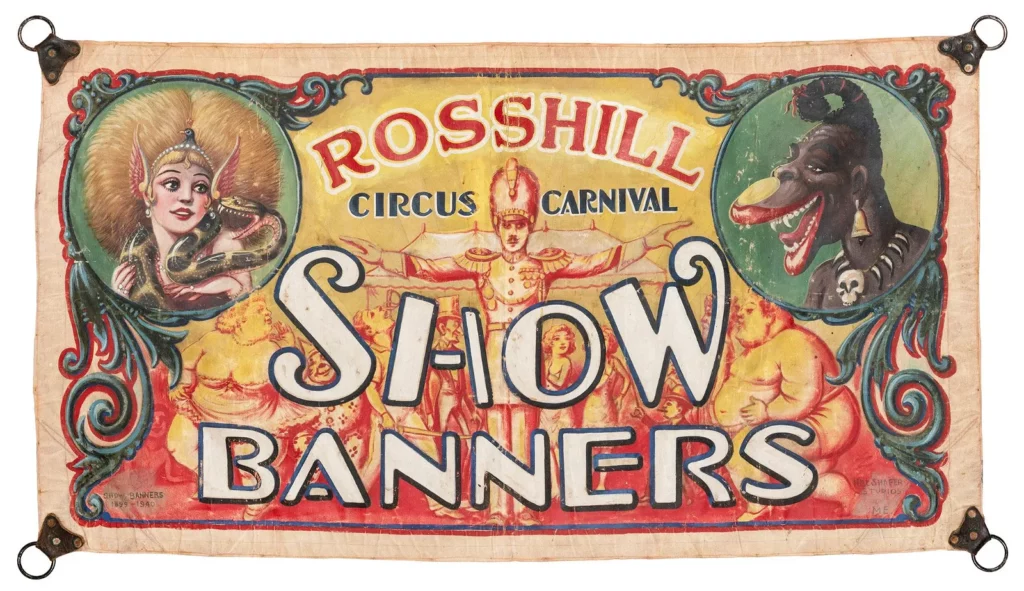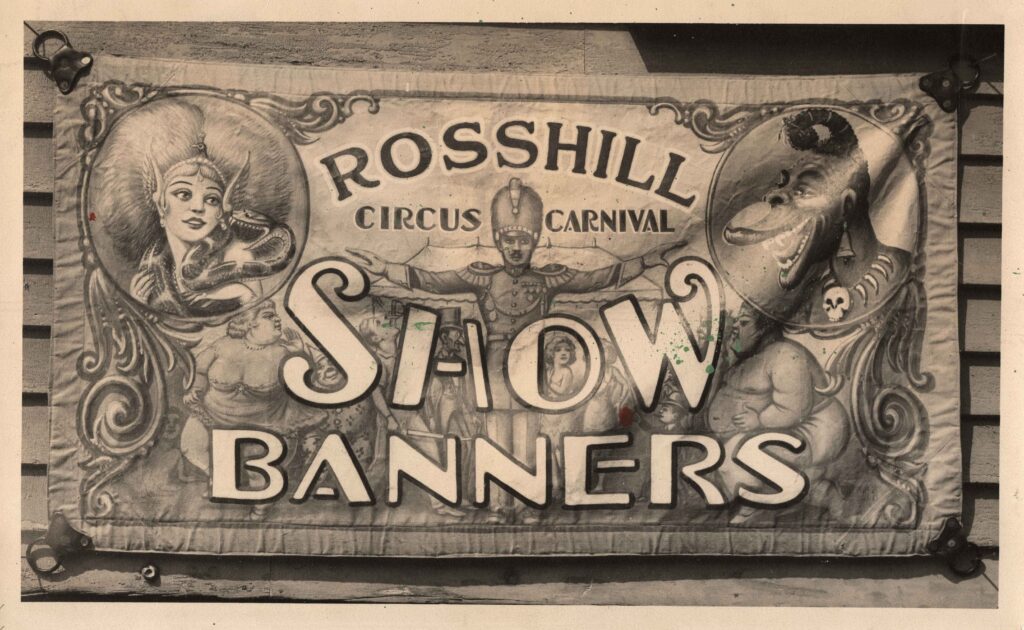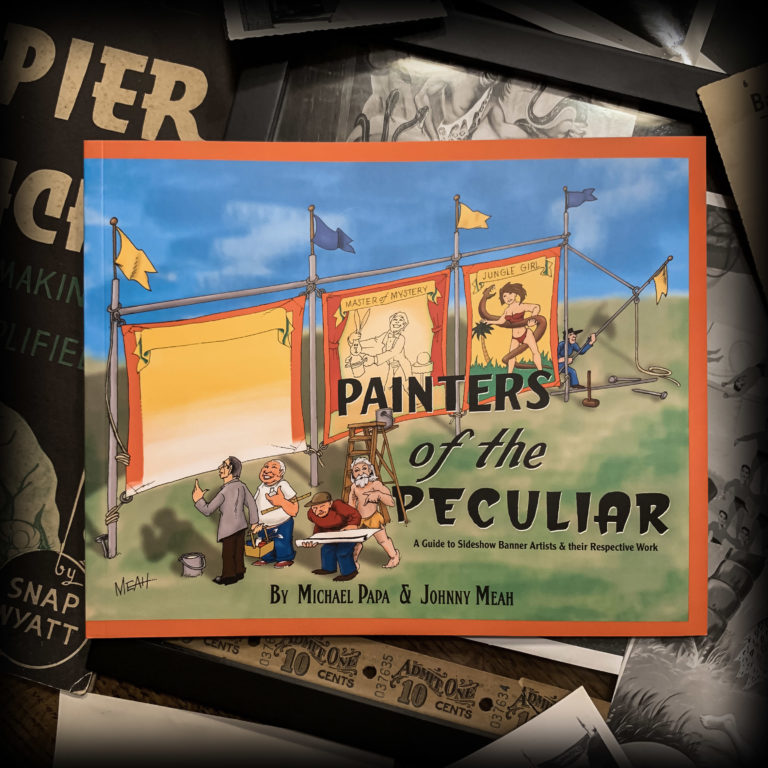The Best of the Best, Cad Hill & the Rosshill Sideshow Banner

The June 2021 Circus, Sideshow and Oddities auction at Potter & Potter displayed quite a few fantastic pieces, and some of the best examples of sideshow banner art still around today. The crown jewel of the banner lots was the Rosshill “Circus Carnival Show Banners” which was clearly used as the main sign for the Rosshill studio when they originally operated. There are many reasons why this banner is a crown jewel, which we will cover here in this article. I was recently given the opportunity to examine this banner up close in personally.
The Artists
Clarence “Cad” Hill, C. Shafer and Charles Ross, who operated out of Falmouth, Maine, are the artists behind this banner. Rosshill Studio is not a well known banner studio like Fred Johnson and Snap Wyatt. This can be attributed to the fact that not many of their banners have survived. Those banners of their’s that have survived, have been locked away in private collections since the 70s and 80s from carousel auctions.
Hill was always regarded as likely the best show banner artist around, due to the sheer quality and detail in his work. This extended through the 50s, 60s and further even after Hill’s retirement. Back in the 70s and 80s, Hill – Shafer – Ross banners and any combination thereof, were going for significantly more money at auction than the average Fred Johnson or Snap Wyatt. Fred Johnson was even quoted as saying “Cad Hill, who I didn’t know- only saw his work – was very much detail, too good for banner work…” in the 1978 book “America’s Forgotten Folk Arts” by Fred & Mary Fried.
Let’s take a small step back and discuss why Fred Johnson said Cad Hill was too good for banner art. To understand that, we need to know what Fred’s frame of mind was in the late 70s regarding banner art. I have long heard from Fred Johnson’s surviving family members that Fred thought of his art as advertising, and that’s really it. He got paid by the hour, not very much, and he just put his head down and got his work done, and it was a hell of a lot of work. So Fred realized that it wasn’t important to spend meticulous hours on one banner when they would be used for shows, and then promptly discarded after they served their purpose, either that same season or 10 years later. Both artists in the Fred Johnson & Cad Hill Era (which overlapped by about 20-30 years) had a sense of urgency, due to the sheer amount of orders they all received. Earlier show banner art like that of Cad Hill, Millard & Bulsterbaum and possibly even Nieman Eisman were a different class of artist who didn’t exactly know any better than the style that they owned. Fred Johnson’s early painting career exposed him to Nieman Eisman, and you can see a bit of Eisman’s influence in Fred’s style. While artists like Hill and Johnson both would understand their work didn’t need to be a masterpiece each time, I think Johnson was more inclined to show less detail, and it’s possible that Johnson may have thought less about banner art in general compared to Cad Hill. Hill may have considered his work very important in a sense of pride, where as Johnson thought it was just a job and not so prestigious, but a job that he enjoyed doing, from what I have heard from his family members. This isn’t to say that Johnson didn’t have as much pride in his work as Hill may have, it’s just that Johnson knew what he needed to get accomplished for his orders and did exactly that, and more if time allowed him.
Fred Johnson’s recognition of Cad Hill says a lot, not only about Hill but Johnson as well, that he respected fellow artists in his trade, ad while being very well respected in his own right, gave Hill the recognition that he deserved. As mentioned before, Hill was well regarded as an artist around the country during his time, however this regard was forgotten for sometime. Advertisements of Hill’s studio, in whatever partner configuration it may have been in (be it Ross, Shafer or Solomon,) at times would blatantly state “If you want the best, go with Hill studio.” Hill used his reputation to his advantage, although this could have been due to later artists like Johnson via O’ Henry Tent and Awning and Snap Wyatt coming on to the scene and undercutting Hill’s prices. This isn’t confirmed, however just a theory.
Fast forward to the 70s and 80s when sideshow banners first started to become collectible, auction houses like Sotheby’s would often have carousel auctions where massive lots of sideshow banners were sold. Many being those of Hill Shafer studio. Nearly all known Hill-Shafer banners that I have ever seen were bought up in these sales, making them very rare to come by now, more than likely being held up in permanent collections across the world. This may have caused the world to forget about Cad Hill, Charles Ross and Jack Shafer for a time. There are passing mentions of this trio here and there in older books like the aforementioned “America’s Forgotten Folk Arts” by Fred & Mary Fried, yet there is not much info about them or their work. I have had serious collectors approach me asking about Hill-Shafer banners, to my regret, when I was asked, I didn’t know anything about Hill-Shafer studio because of the rarity of their work and information about them.
Ross-Hill-Shafer
What’s still not completely cut and dry about the Ross-Hill-Shafer partnership, is who did what and when. We can inference some things from ads and a single newspaper article but not everything. For instance, it is pretty clear that Hill first worked with Solomon, however, what Solomon did was unclear and it did not seem as though their partnership lasted long nor recorded well. Ross worked on and off with Hill throughout their careers. It appears that Shafer was partnered with Hill in the beginning of Hill’s career in the late 1800s continuing into the early 1900s, before and during Ross’ reunion with Hill in 1912. There are records of Ross, Hill and Shafer advertising together and also banners with Hill-Shafer Studio, along with separate banners and ads reading Rosshill Studio. It seems that Hill did a majority of the painting work, however it is possible that both Ross and Shafer were sign and scenery painters. From original advertising drawings that still exist today, it seems as though Hill had a talent for the whole process of banner painting. It’s possible that Ross and Shafer were both assistants to Hill, or each did their own entire banner work. From a 1936 article in the Portland Evening Express, we know Cad Hill lost both of his legs due to an accident. For years he sat in a wheelchair completing drawings and small paintings, some of which drawings still exist today. It is clear that he continued to paint banners for a while after this happened, as there are drawings of him painting while sitting on an elevated and movable stand. There are examples of Rosshill and Hill Shafer studio banners out there today that do not line up with the quality of the average banner from either studio. What I suspect is that when Hill had his accident, Ross and or Shafer picked up the slack and couldn’t deliver the quality that Hill could, until he was able to paint full banners again.
Hill’s banner painting is quite honestly above and beyond the work of other banner artists. Typically sideshow banner artists perfect a quick and sometimes dry brush stroke that results in a painting that is done quickly, but also very properly represents the subject without that much work. As discussed before, the sheer amount of orders these artists would receive resulted in a need for this fast paced artwork. To me, that is why banner art is so amazing, because they all perfected this method that looked great and yet was not time consuming compared to traditional art. Hill on the other hand, used this technique, but was much more detailed to the point where it doesn’t really look like a painting. There is much more realism, not as many dry strokes that create faux form, more of a true form. Some of the styling of his work is reminiscent of Italian renaissance work. The important thing about Hill’s work and style, is he usually painted very beautiful paintings, where as some painters like Jack Sigler can have very ugly figures or animals, Hill’s work was usually very aesthetically pleasing, even for subjects there were intended to be ugly.
The Provenance & Inspection of this Banner
Recently I had the opportunity and permission from the current owner to personally inspect and study the Rosshill banner featured in this article. The banner features a gallery of sideshow characters ghostly painted into the background behind and almost interacting with the text, reading “Rosshill Circus Carnival Show Banners” in an elegant yet classic Cad Hill typeface. In the two super corners are depictions of a Circassian snake charmer and a caricature of an Ubangi gaze which are both encased in the most elaborate scroll work I have ever seen on a banner with a faux three dimensional painting. Some may be offended by the caricature of the Ubangi, however this is how they were depicted back then to incite curiosity, “is that how they really look?”
In my research, prior to inspection, I was able to find an original photo of this exact banner hanging outside the Rosshill studio in Falmouth, ME, and acquire it for the current owner of the banner. I know this to be the outside of their studio because of a photo from the 1936 newspaper article that shows the same wood siding on the building where Ross was painting.
By my estimation, this photo was taken sometime post 1930. The reason this can be inferred is because in the photograph, you can see the bottom left corner reads “193_” with the underscore representing a blank space, because now, the banner reads “1899-1940”. What’s more, is that clearly the writing in the bottom corner of the banner was edited to show 1940 instead of 193_. This could also mean that this banner could have been painted anywhere between 1899 and 1939. I am leaning to closer to the 20s or 30s because Cad Hill’s history with Charles F. Ross wasn’t in full swing until 1912. We know for sure that Cad Hill and Charles Ross worked in the Falmouth studio in 1936, as per a newspaper article, however we do not have a firm date on the establishment of that particular studio.

Inspecting the banner further, I found that shining light through the front and viewing the back shows that the Rosshill arched typography was covering the words “Odd But True.” Interestingly, the banner is also signed Hill-Shafer Studio, ME. So here is my theory. We know the end result, that it was more than likely repurposed to be used as the sign hanging outside at their studio. I suspect the banner was painted by Cad Hill when Shafer was still around. The upper text originally said “Odd But True” and may not have had “Show Banners” on it to start. This change may have been done for two possible reasons. First, it could have been a cancelled order for an “Odd But True” Gallery banner which was then repurposed. The second possibility would be that Cad painted this banner, in a smaller format, after his accident and losing his legs to work up to painting full banners again. If this were the case, he may have originally written Odd But True Show Banners with Hill-Shafer and the date with the blank space. Then when Shafer either left or passed away, he changed the text to read Rosshill instead of Odd But True, then using it as the sign to their studio.
Sideshow banners in general are decently rare because of their lack of preservation in the decades prior to 1980. However, this particular banner is very special, not only because it was painted by Cad Hill, who is arguably the best there ever was in this minuscule field of advertising art. Also because it was the literal sign for their studio and it is still around today with an original photo proving this to be the case. With a reasonable amount of certainty, it is possible this parrticular banner was the reason why Cad Hill was so well known in his time. He certainly worked hard to over embellish this banner so that everyone knew he was a great talent. Having his customers and other people in the trade see this particular banner, probably made it clear in that time, that he was the best, and also explaining the reasoning behind most of his print advertising stating all banners were painted by “Hill Himself.” It’s rare for banners to survive so long, but even more rare for one with such an interesting history, condition and age of roughly 100 years old to survive. It was an amazing opportunity to see and inspect this banner in person. My only hope from here is that more Cad Hill work is discovered and persevered for future generations.
If you have any sideshow banners or Cad Hill – Rosshill – Hill Shafer banners for sale, I would love an opportunity to buy them or even see them. Please contact me at michaelpapa121@gmail.com or 518-774-6234.

